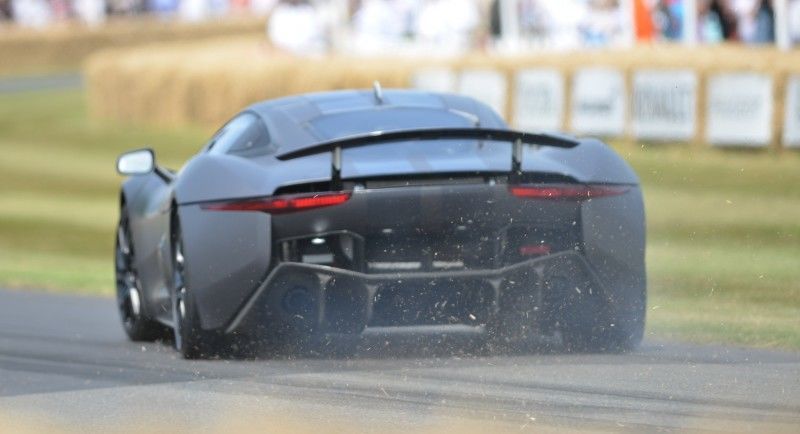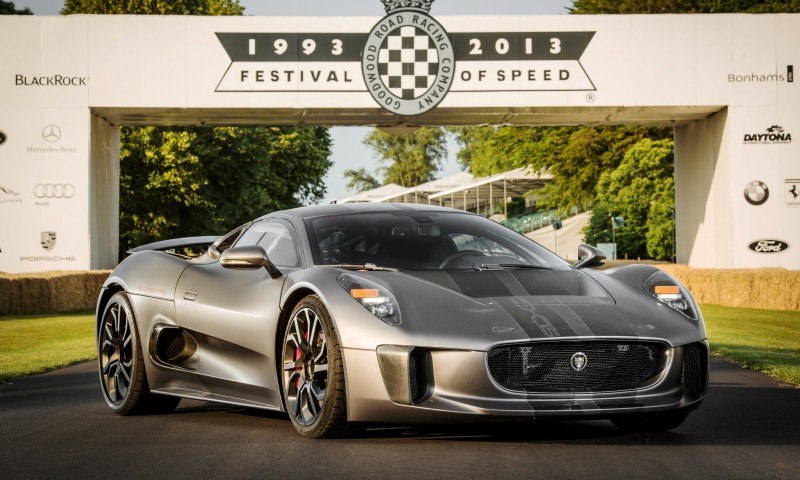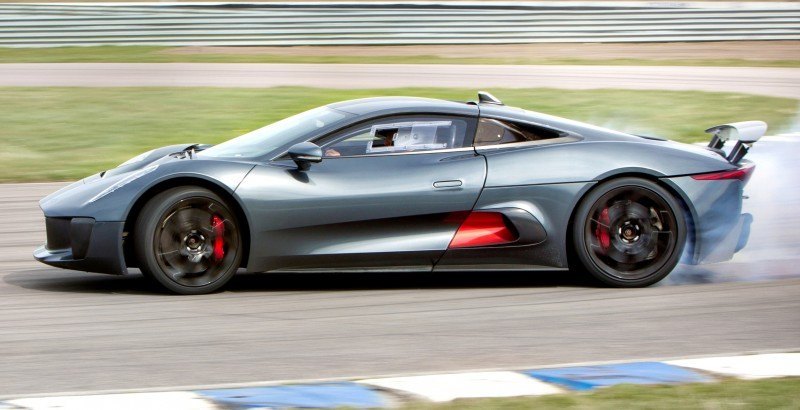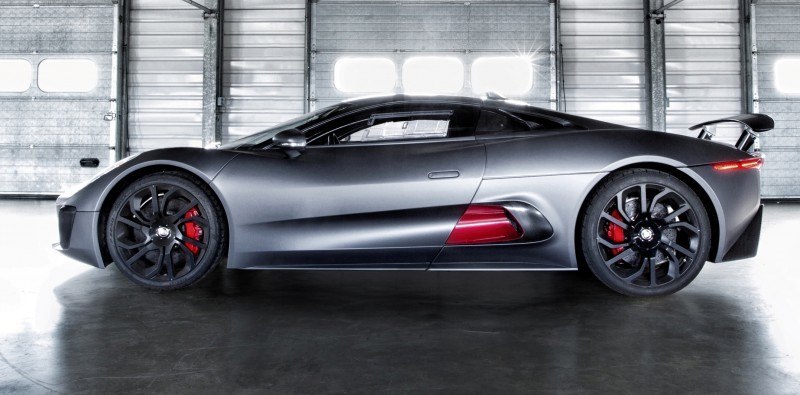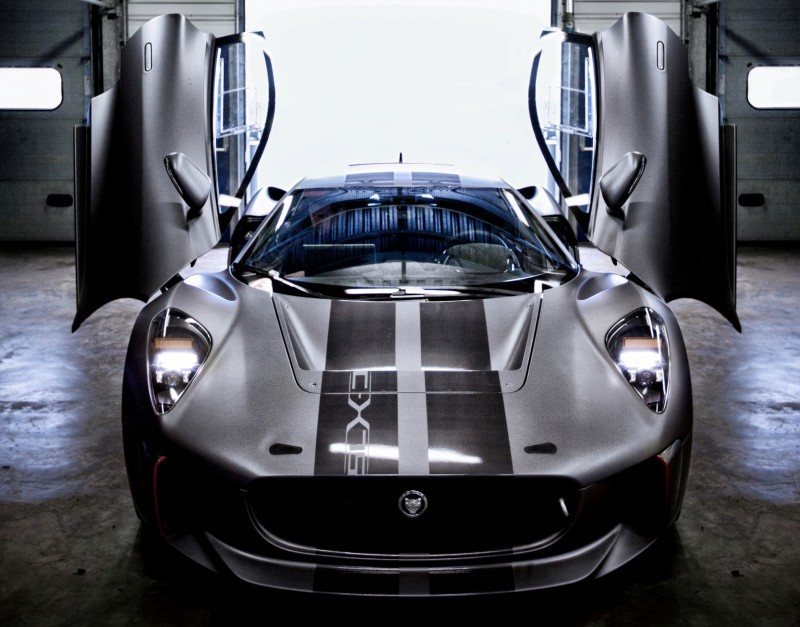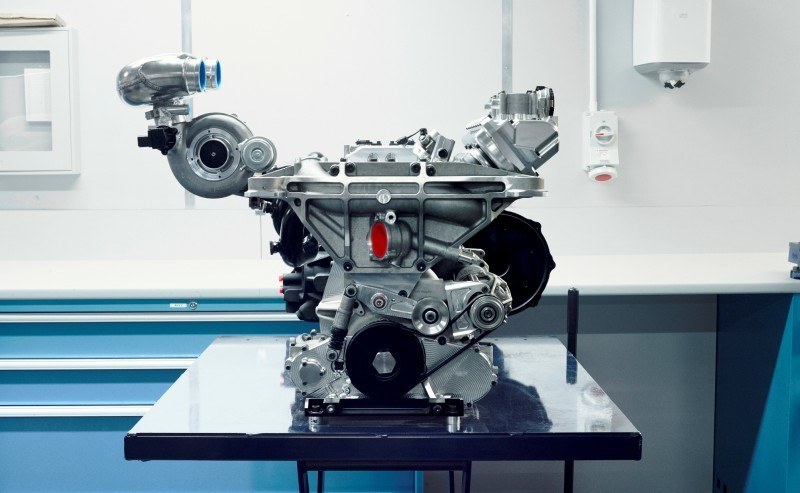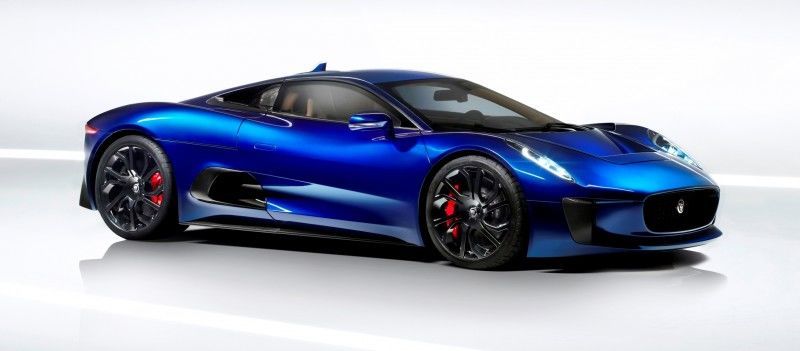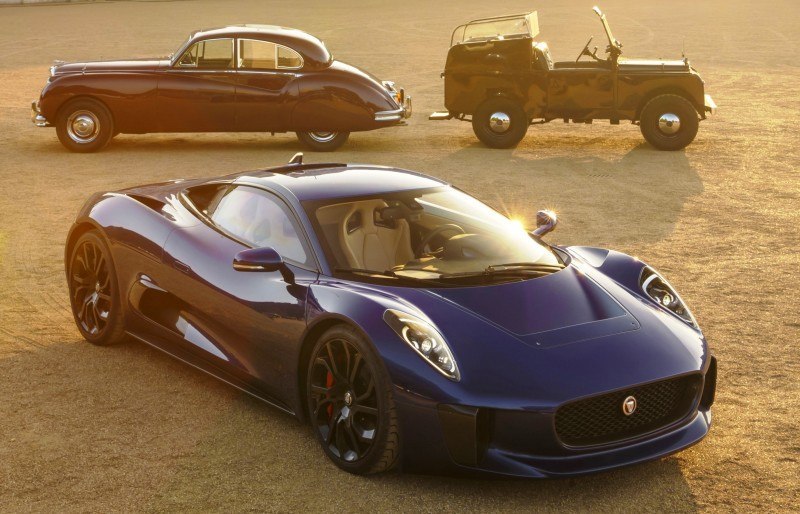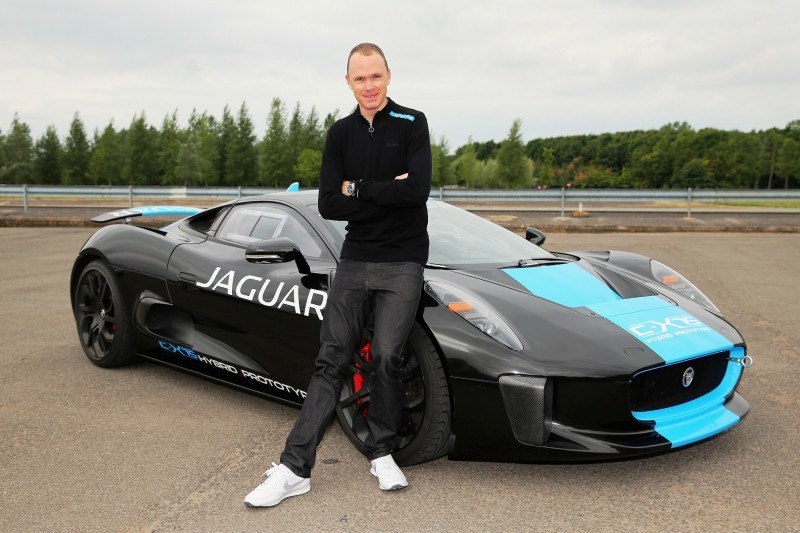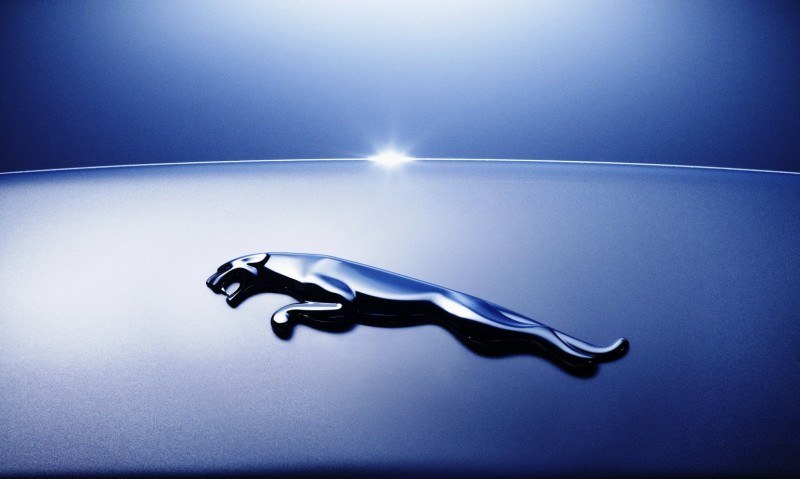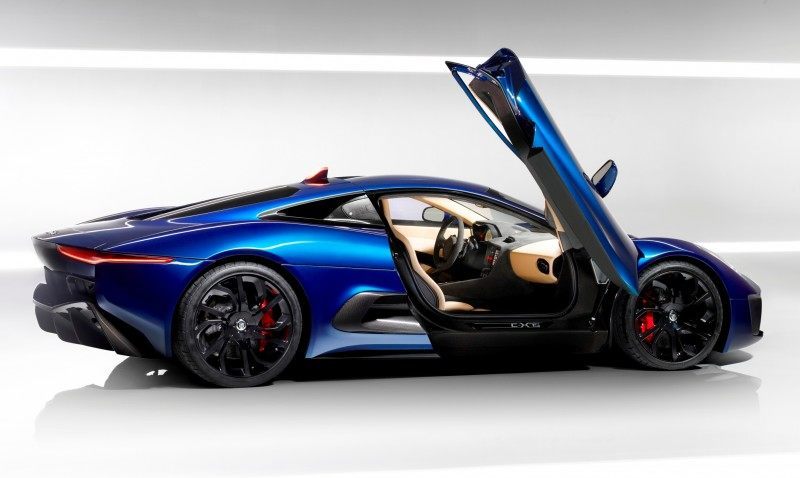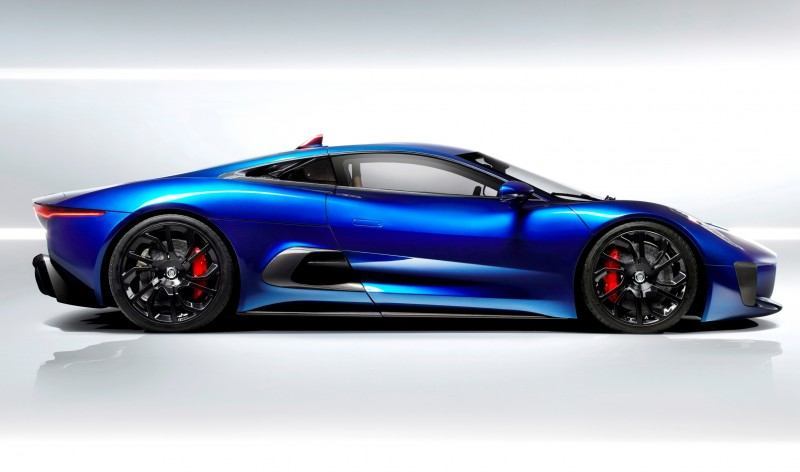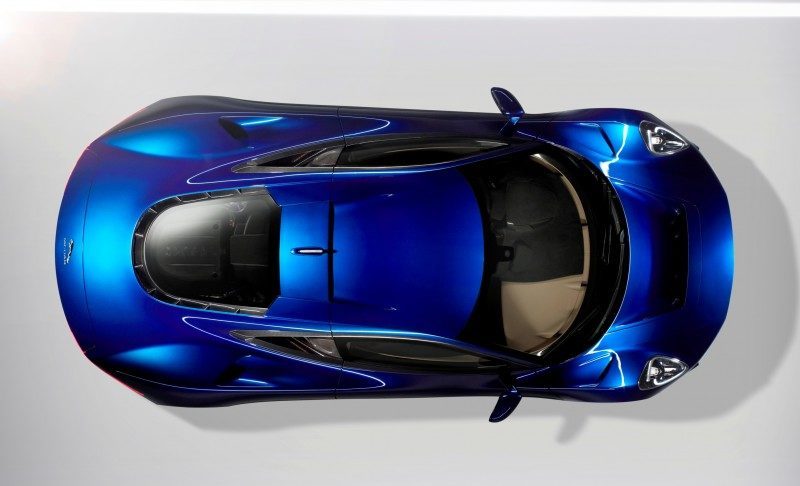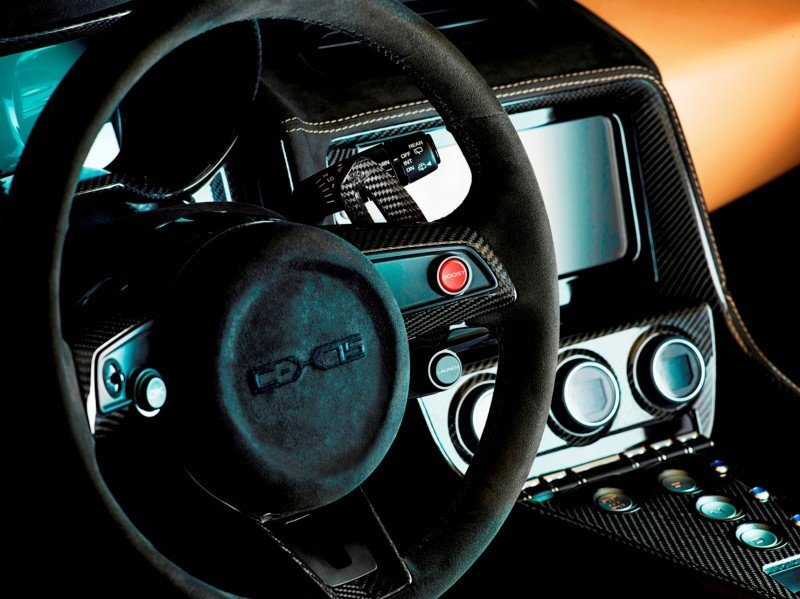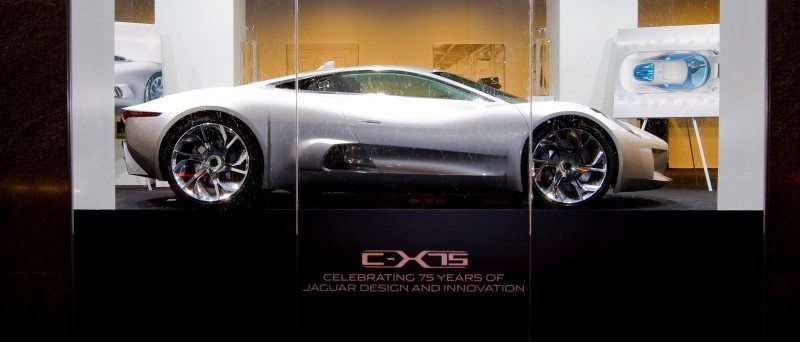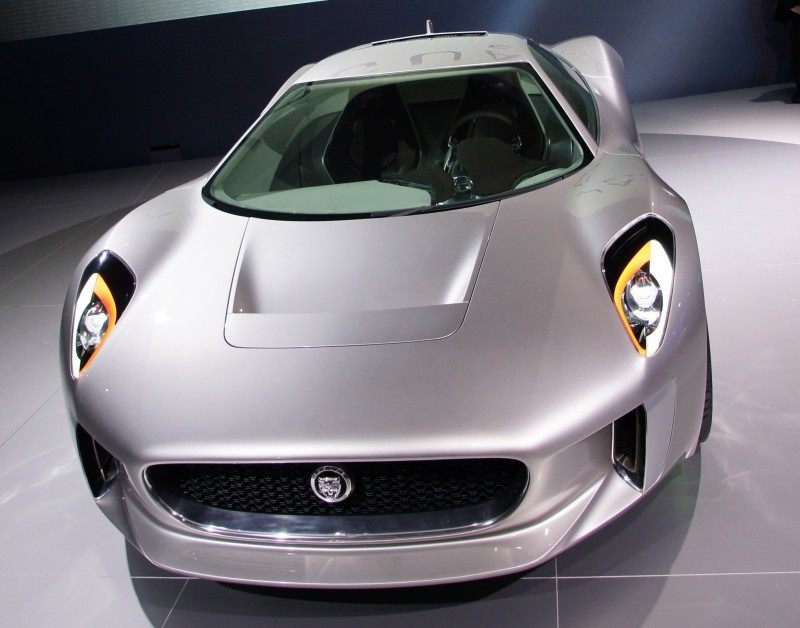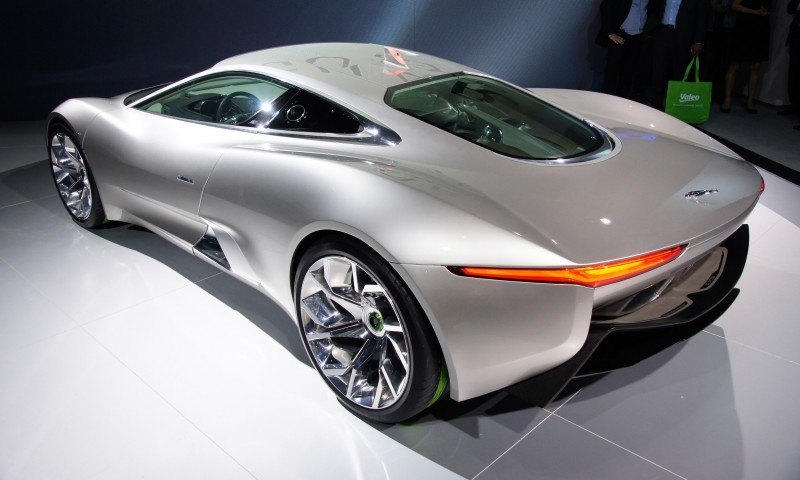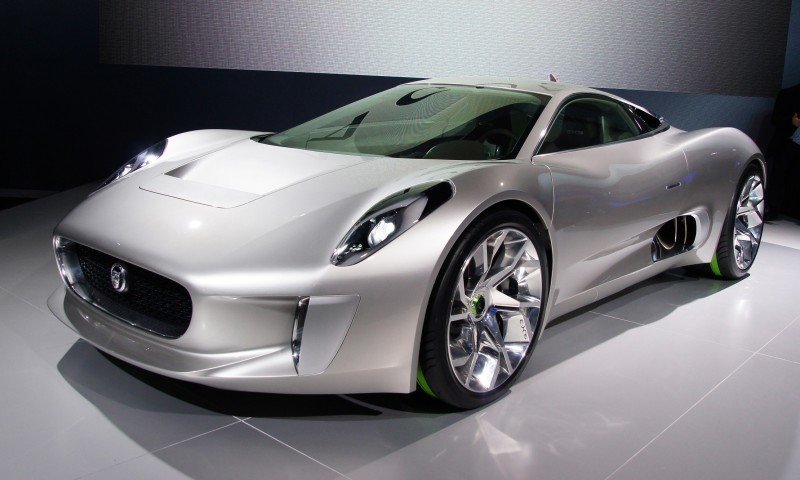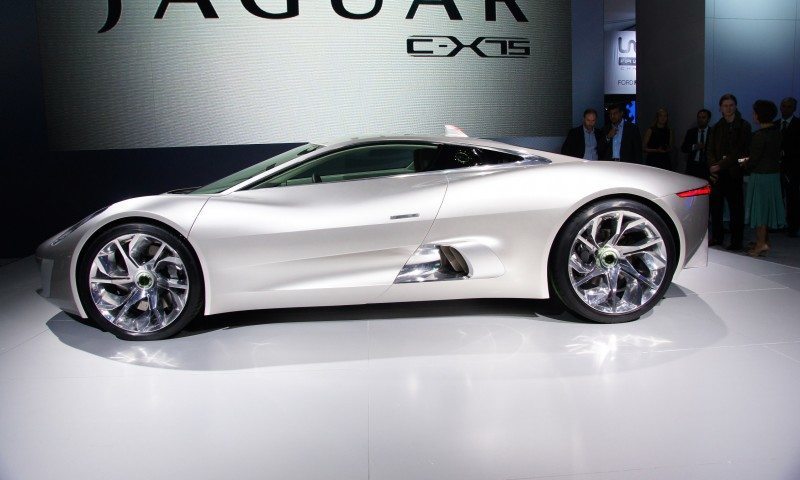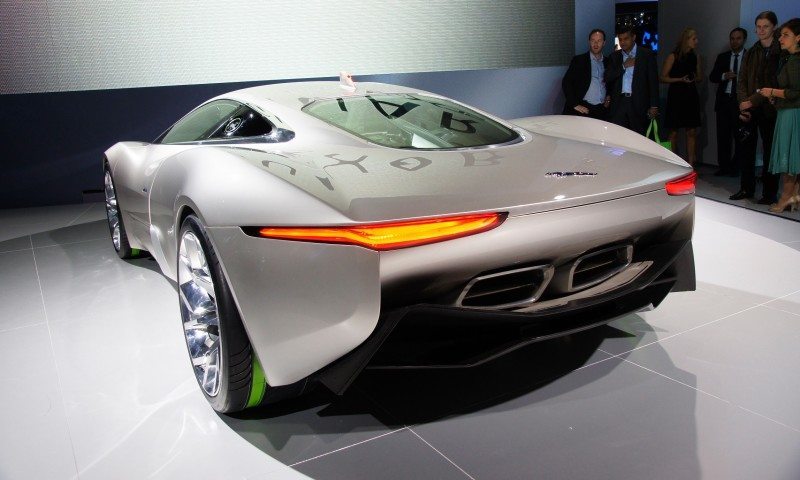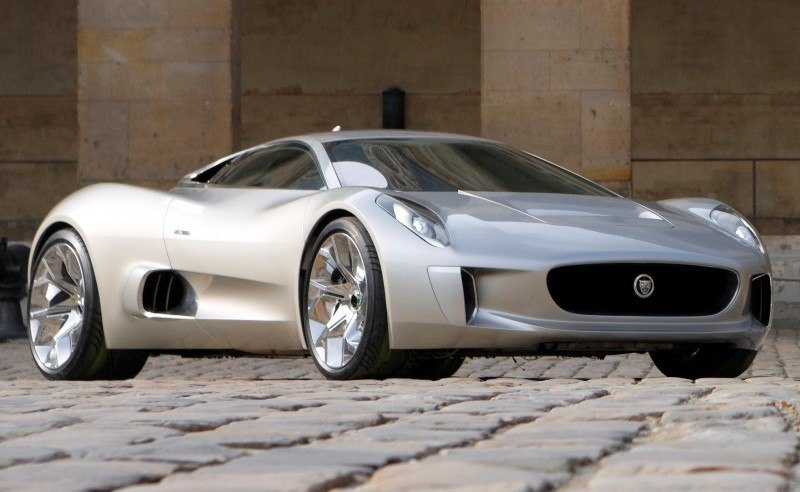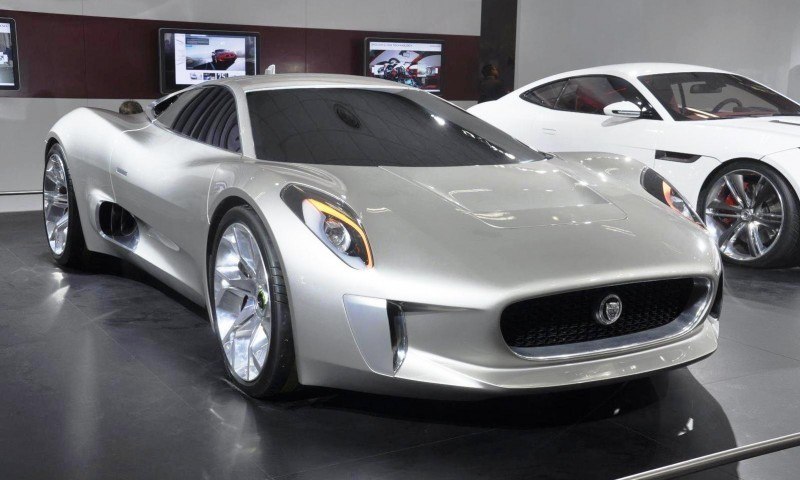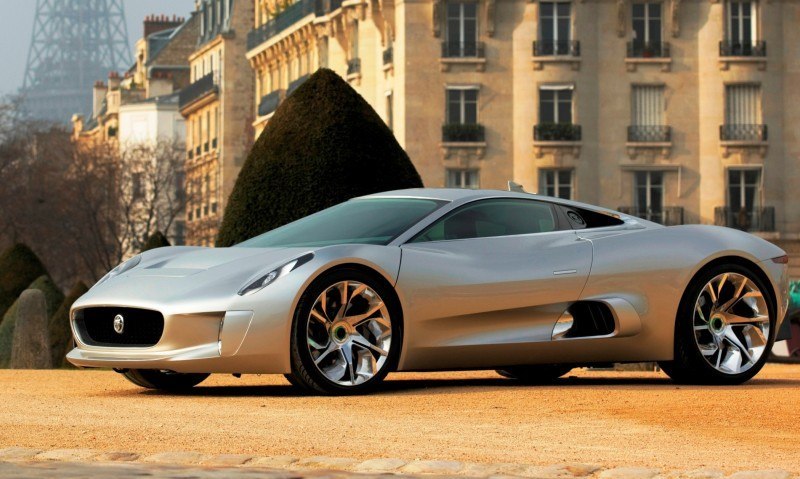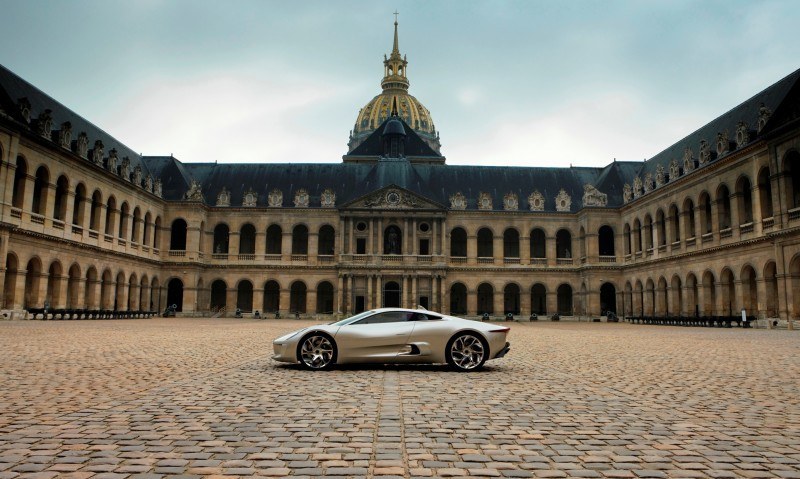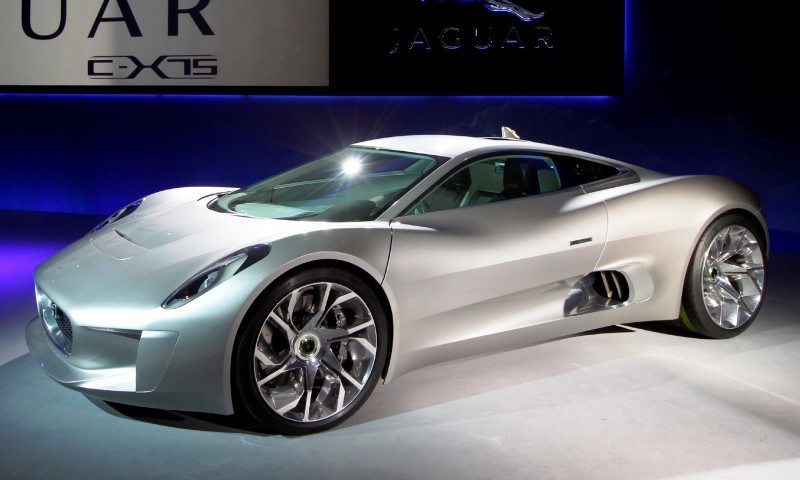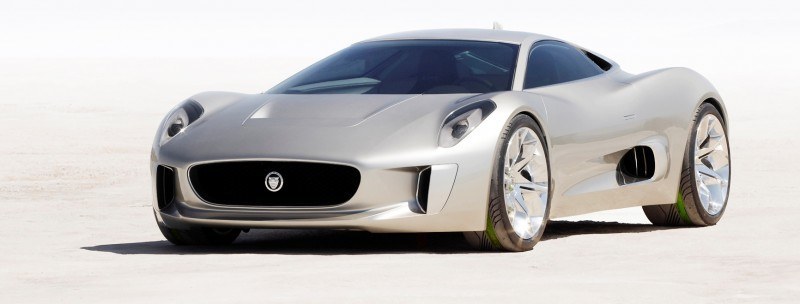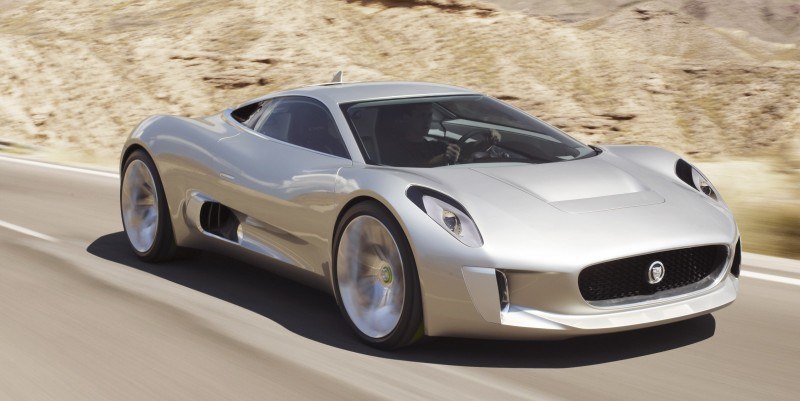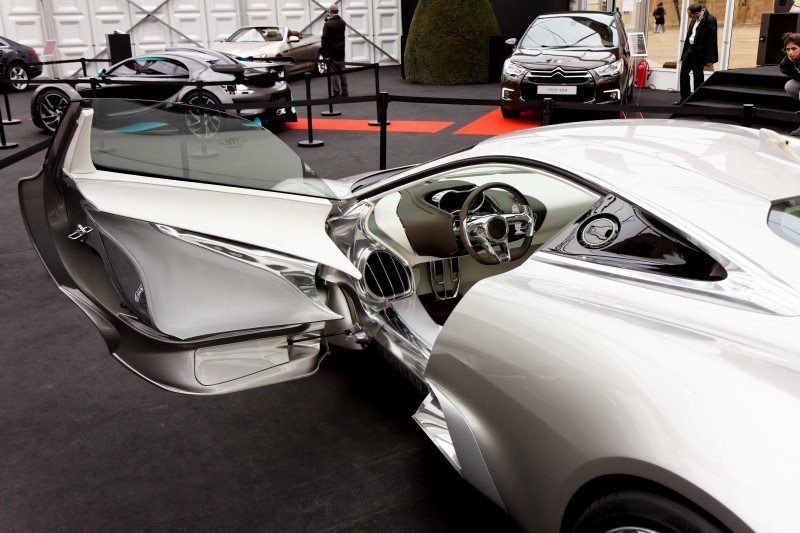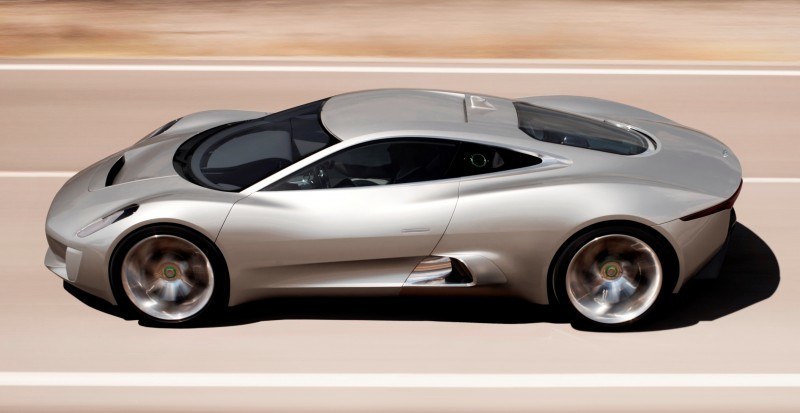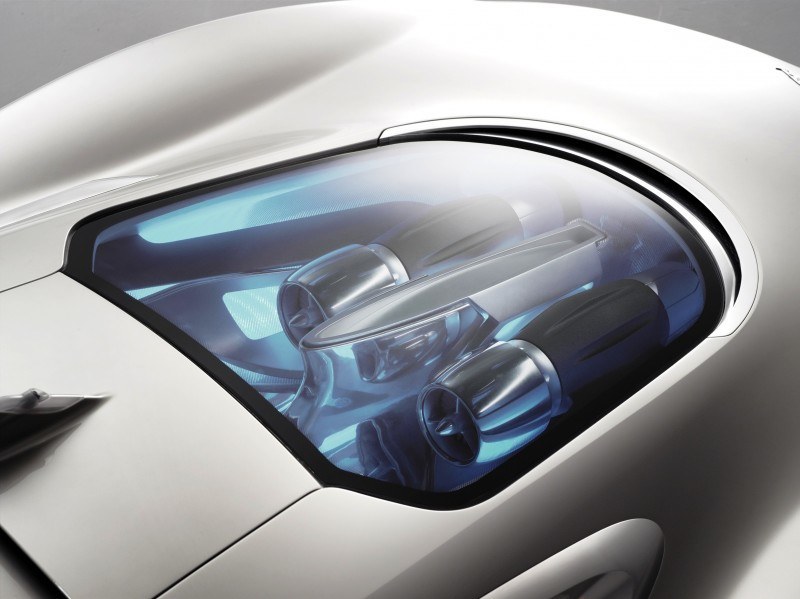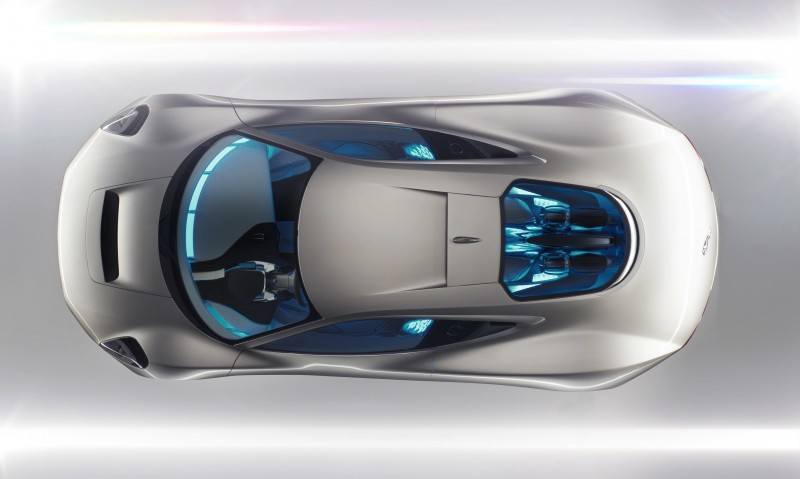Too sexy for Milan, New York and Japan?
Just kidding.
Despite the jokey “I’m too sexy” headline, the Jaguar C-X75 really could do no wrong when it debuted in Paris in 2010. It was a design so captivating that they painted it a dull beige – and people still went absolutely mad for it.
As you can see in the difference between the 2010 Paris announcement at the bottom, and the production announcement in 2011 directly below — the car had a rough gestation period. The initial gas turbine hybrid technology was no-where near production feasible, and the truly jet-age powertrain was to be replaced with a jumbo Prius-style dual-mode hybrid.
So it was a little underwhelming from the get-go of the production announcement, especially versus the V-12 hybrid LaFerrari, V8TT PHEV McLaren P1 or the Porsche 918 Spyder and its atmospheric V8 PHEV.
Moreover, performance was likely to be a stretch goal with just a four-cylinder twin-charged engine doing to main motivation, and the batteries inevitably weighed far more than the initial claims. The real game-killer for the Jaguar was two-fold:
— horrible name. Try saying this with pride or lust. “CX75” sounds like a weight of paper towels or something else from the boring part of the supermarket
— horrible timing. The hypercar market is saturated at the moment with true contenders
But truly – as a thing a of beauty and a mark of Jaguar’s renewed sense of purpose once free from Ford, the C-X75 did its job wonderfully.
2011 JAGUAR C-X75 Prototype
JAGUAR TO BUILD C-X75 HYBRID SUPERCAR
- Jaguar to launch C-X75 as a hybrid supercar
- Mixes internal combustion power with electric motors to achieve supercar performance and less than 99g/km CO2 emissions
- Downsized highly boosted petrol engine with two powerful electric motors and four-wheel-driveAll-electric running range in excess of 50km
- 0-60mph in less than 3 seconds
- 0-100mph in less than 6 seconds
- Top speed in excess of 200mph
- True-to-concept, lightweight, all carbon-fibre chassis
- Groundbreaking association with Williams F1 – built in the UK
- Direct technology transfer from top-level motorsport
- Prices from £700,000 depending on local market and taxes
- Exclusive limited volume hybrid supercar – only 250 will be built
Jaguar can today confirm that it will launch the remarkable C-X75 concept car as an exclusive hybrid supercar.
Jaguar C-X75 will become the British marque’s most advanced model to date. It will offer performance on a par with the fastest production cars on the market, while adopting cutting-edge technology that offers remarkably economical running. Jaguar expects this hybrid supercar to deliver incredibly low CO2 emissions of less than 99g/km while being able to achieve in excess of 200mph.
“People expect Jaguar to be innovators − that is when Jaguar is at its best,” said Adrian Hallmark, Jaguar Brand Director. “The C-X75 received an incredible reception as a concept car. We’ve been building on that momentum and there is a clear business case for this exclusive halo model. No other vehicle will better signify Jaguar’s renewed confidence and excellence in technological innovation than this.”
Project C-X75 will be the ultimate expression of Jaguar design and engineering innovation. This high-performance hybrid supercar will stay true to the initial concept design study that made its debut at the 2010 Paris motor show, while fulfilling requirements that allow it to be homologated for road use.
“We were always determined that the Jaguar C-X75 would be as striking on the road as it was in concept form,” said Ian Callum, Director of Design, Jaguar Cars. “This will be the finest looking and most innovative Jaguar ever produced. Even in the world of supercars, we can still produce the most beautiful.”
In an unprecedented move, Jaguar C-X75 will be developed in association with Williams F1 who will provide their engineering expertise in areas including aerodynamics, carbon composite manufacture and hybrid technologies. This association will be at the leading edge of British automotive engineering and innovation.
“Confirmation of this project today signposts Jaguar Land Rover’s continued determination to embrace new technologies,” said Jaguar Land Rover CEO, Dr Ralf Speth. “A supercar like the C-X75 is the logical choice to showcase cutting-edge design, intelligent use of new environmental technologies and motorsport-inspired performance.”
It also marks a new milestone in both companies’ histories as Jaguar Land Rover and Williams collaborate for the first time to produce one of the world’s highest performance and environmentally sustainable supercars. The production of Jaguar C-X75 will create more than one hundred highly-skilled jobs in the UK.
A direct technology transfer between elite motorsport and road-going production cars is key to C-X75’s success. The supercar’s chassis will be made of carbon-fibre to create an incredibly lightweight, yet rigidly strong structure.
Aiding the transition from concept to production vehicle is the choice of powertrain. Jaguar continues to develop the use of the micro-turbine technology that was showcased in the original concept C-X75. Jaguar’s parent company Tata has taken a significant stake in Bladon Jets, and will develop this very advanced technology as a medium-term aspiration that will play a part in Jaguars of the future.
To bring Project C-X75 to showroom reality within the timescales of a conventional model programme, an equally innovative powertrain had to be developed. The road-going supercar will use a state-of-the-art, small-capacity, highly-boosted internal combustion engine with one powerful electric motor at each axle.
“The engine’s compact size allows it to be mounted low in the car for optimum weight distribution and to retain the concept’s stunning silhouette. This will make the Jaguar C-X75 a bona fide hybrid supercar capable of silent electric running with an extensive EV range in excess of 50km,” explained Bob Joyce, Group Engineering Director, Jaguar Land Rover.
When C-X75’s motors and combustion engine combine, it will be one of the fastest production cars in the world, with a sub-three second 0-60mph time and a top speed in excess of 200mph. Crucially, this performance will be generated alongside incredibly low emissions, with a target of less than 99g/km CO2, thanks to Project C-X75’s lightweight construction and cutting-edge powertrain technology.
Williams F1 has been at the forefront of motorsport engineering for three decades. The project engagement on Jaguar C-X75 is testament to the team’s ambitions and will bring together two leading lights of the UK motoring industry.
“Our new association with Jaguar Land Rover provides us with an exciting opportunity to work with one of the motoring world’s most famous and iconic brands,” said Sir Frank Williams, Chairman of Williams F1. “Williams has always considered itself an engineering company and so this project will allow us to combine our technical expertise to create something truly exceptional.”
Jaguar C-X75 will redefine the customer experience, and will set new standards in sales and after-sales services that will be recreated across the range in the future. Only 250 examples will be built, each costing between £700,000 – £900,000 depending on market and local taxes.
“Never before has the company launched such an ambitious, world-beating vehicle programme,” said Carl-Peter Forster, CEO Tata Motors. “This is the Jaguar of the future. The opportunity for innovation like this in the UK is part of the reason Tata Motors invested in Jaguar, and it’s fantastic that products like the C-X75 can become reality.”
From today Jaguar will be taking expressions of interest via its website www.jaguar.com
2010 JAGUAR C-X75
JAGUAR C-X75 CONCEPT – FOUR-WHEEL DRIVE ELECTRIC SUPERCAR UNVEILED AT PARIS
- Stunning range-extended electric supercar concept
- A celebration of 75 years of beautiful, fast Jaguars, points the way to a new design language
- Capable of reaching 330km/h (205mph), sprinting from 0-100km/h (62mph) in just 3.4 seconds and blistering acceleration from 80-145km/h (50-90mph) in just 2.3 seconds
- Four powerful 145kW (195bhp) electric motors – one for each wheel – produce 780bhp and an astonishing total torque output of 1600Nm (1180lb ft)
- Two micro gas-turbines, spinning at 80,000 rpm, can generate enough electricity to extend the range to a remarkable 560 miles; and produce just 28 grams of CO2 per kilometre from the car’s plug-in charge capability
- A zero tailpipe emissions range of 110km (68 miles) while running solely on battery power
Jaguar has revealed a stunning range-extended electric supercar concept car. The C-X75 has been designed to celebrate 75 years of the marque and provide a glimpse into the future of Jaguar and its commitment to producing beautiful, fast cars powered by sustainable means.
“The C-X75 is a tribute to the people who shaped the iconic Jaguars that are revered to this day. By making it an innovative test-bed for the technologies of tomorrow, it also ensures that our reputation for engineering excellence will continue for another 75 years and beyond.”
Mike O’Driscoll, Managing Director, Jaguar Cars
75 Years of Jaguar Design
The C-X75 hints at an exciting evolution of Jaguar’s design language while paying homage to some of its most admired cars of years gone by. Advanced design features such as a ground-breaking propulsion system and active aerodynamics allow for an elegantly simple fuselage section that remains stable at very high speeds.
The C-X75 is finished in Jetstream Silver, its designers staying true to the long-held Jaguar design philosophy of natural, flowing lines and simple, elegant forms. Where inspiration from the past was found is in the innovative engineering and functional design elements of cars like the 1950s C-Type and D-Type racers and unique 1966 XJ13 Le Mans prototype – a car described by Callum as, “arguably the most beautiful Jaguar ever made”.
Shorter and lower than the current crop of supercars, its exterior design is about pure performance with a simple central fuselage surrounded by prominent wheel arches. Thanks to the packaging efficiencies provided by the absence of a conventional piston engine, the car’s designers had maximum freedom in placing the mechanical components and creating the most elegant engineering package available.
“The C-X75 is everything a Jaguar should be. It possesses remarkable poise and grace yet at the same time has the excitement and potency of a true supercar. You could argue this is as close to a pure art form as a concept car can get and we believe it is a worthy homage to 75 years of iconic Jaguar design.”
Ian Callum, Design Director, Jaguar Cars
Propulsion system
The 330km/h (205mph) four-wheel drive supercar is capable of running in purely electric (zero tailpipe emissions) mode for 110km (68 miles) on a six-hour domestic plug-in charge. The innovative, lightweight micro gas-turbines are also capable of very quickly and efficiently recharging the Lithium-ion batteries, giving the car a theoretical range of 900km (560 miles).
This remarkable range-extension system is a result of Jaguar’s research engineers adopting a clean-sheet approach to the question of powering the supercars of the future. The C-X75 turns to the very latest evolution of a pioneering British technology: the gas turbine.
Developed in partnership with Bladon Jets, the miniaturised turbine blade – the first viable axial-flow micro-turbine – increases the compression and efficiency of micro gas-turbines to the point at which they can be viewed as a realistic power source. Each of the micro gas-turbines weighs just 35kg and produces 70kW of power at a constant 80,000rpm.
Power and control
The energy created by the turbines and stored in the batteries is transmitted to the road using four independent electric motors. Using individual motors has benefits in terms of weight-saving and distribution, packaging and efficiency. Each motor weighs just 50kg but produces 145kW (195bhp) of power and an astonishing combined total torque output of 1600Nm (1180lb ft).
Because each wheel is driven by its own electric motor, the C-X75 is four-wheel drive – with all the traction, grip and safety benefits that entails – without the weight disadvantages of a purely mechanical set-up. Inherent in this drivetrain is the ability to independently vector torque to each wheel across the full speed range. This offers potential benefits in terms of stability and control, creating an infinitely and instantaneously adjustable traction and stability control system.
Driver-focused cabin
With the seats fixed, the steering wheel, controls, main binnacle and pedal box all adjust towards the driver. The seats are attached to the bulkhead as in a single-seater racing car, and air to feed the turbines passes smoothly around them via channels in the structure of the body.
A new interface for the driver has also been created for the C-X75 using high-resolution TFT screens. Building on Jaguar’s 10-year expertise in touchscreen technology, the Jaguar Co-Pilot display in the centre console supports the driver in extracting the full potential of the C-X75 by seamlessly managing information.
The main driver information screen is housed within the instrument binnacle. Needles float on the periphery of the twin cowls and sweep round the outer edge to display the status and rpm of the two turbines. The design team combined designs from instrumentation in the new XJ saloon with those from fighter aircraft to create virtual 3D ‘gimbals’ around which the gauges wrap and rotate to provide status updates.
75 years of innovation
“Performance through innovation has always been a Jaguar trademark. From the beginning, cars such as the C-Type and D-Type pioneered aluminium construction, aerodynamic design, racing monocoques and disc brakes. The C-X75 demonstrates that Jaguar is still leading the field automotive design and technology. And will always continue to build beautiful, fast cars.”
Ralf Speth, Chief Executive Officer, Jaguar Land Rover
Advanced aluminium lightweight construction
Jaguar’s expertise in the use of aluminium stretches back more than 50 years to the first XK120s, through the lightweight E-Types, the XK and all-new 2010 XJ. It was with this latter creation that Jaguar fully realised the lightweight metal’s benefits to performance, agility, economy and sustainability in a luxury car.
The C-X75 naturally follows the same construction techniques with an extruded and bonded aerospace-inspired aluminium chassis clad in panels of the same material. Not only does this save weight, crucial in a car with an extreme performance envelope, but aluminium is one of the most easily recyclable metals available, boosting the C-X75’s sustainability as well as its speed.
Active Aerodynamics
Aerodynamics have always played a large part in Jaguar design with the late designer Malcolm Sayer elevating it into an art form in cars such as the XJ13, the prototype from which the C-X75 draws inspiration.
Jaguar has increased the design’s aerodynamic efficiency dramatically by opening the front grille and brake cooling vents only when necessary. At the rear corners of the car vertical control surfaces automatically engage at higher speeds to direct airflow aft of the rear wheels for increased stability and efficiency.
The carbon-fibre rear diffuser, a crucial element in guiding airflow under the car and creating downforce includes an active aerofoil, which is lowered automatically as speed increases. Vanes in the exhaust ports then alter the directional flow of the gases to further increase the effectiveness of the Venturi tunnel.
For the full press pack, please log onto www.media.C-X75.com.
Technical Specifications
| Propulsion System & Transmission | |
| Electric motor | Four 145kW (195bhp) traction motors (580kW/780bhp total) |
| Generator | Two switched reluctance generators |
| Range Extender power | 2 x 70kW (94bhp) gas micro-turbines (140kW/188bhp total) |
| Batteries | Lithium-ion |
| Total Battery Capacity (kWh) | 19.6 |
| Transmission | Single-speed |
| Final Drive Ratio | 3.1:1 |
| Performance | |
| 0-100km/h (seconds) | 3.4 |
| Top Speed (km/h/mph) | 330/205 |
| 0-160km/h (seconds) | 5.5 |
| 0-300km/h (seconds) | 15.7 |
| 1/4 mile (seconds@km/h) | 10.3@251 |
| Max. Power (kW/BHP) | 580/780 |
| Max. Torque (Nm/lb ft) | 1600/1180 |
| Power to Weight ratio (BHP/tonne) | 578 |
| Aerodynamics (Cd) | 0.32 |
| Economy | |
| EV range (km/miles) | 110/68 |
| Extended range (km/miles) | 900/560 |
| CO2 emissions (g/km) | 28 |
| Fuel tank capacity (litres) | 60 |
| Dimensions | |
| Wheelbase (mm/inches) | 2725/107.28 |
| Overall Length (mm/inches) | 4647/182.95 |
| Overall width (mm/inches) | 2020/79.52 |
| Overall Height (mm/inches) | 1204/47.40 |
| Kerb weight (kg) | 1350 |
| Wheel size front and rear (inches) | 21 and 22 |
| Tyres (front and rear) | 265/30 ZR21 and 365/25 ZR22 |
| Battery weight (kg) | 230 |

Tom Burkart is the founder and managing editor of Car-Revs-Daily.com, an innovative and rapidly-expanding automotive news magazine.
He holds a Journalism JBA degree from the University of Wisconsin – Madison. Tom currently resides in Charleston, South Carolina with his two amazing dogs, Drake and Tank.
Mr. Burkart is available for all questions and concerns by email Tom(at)car-revs-daily.com.




